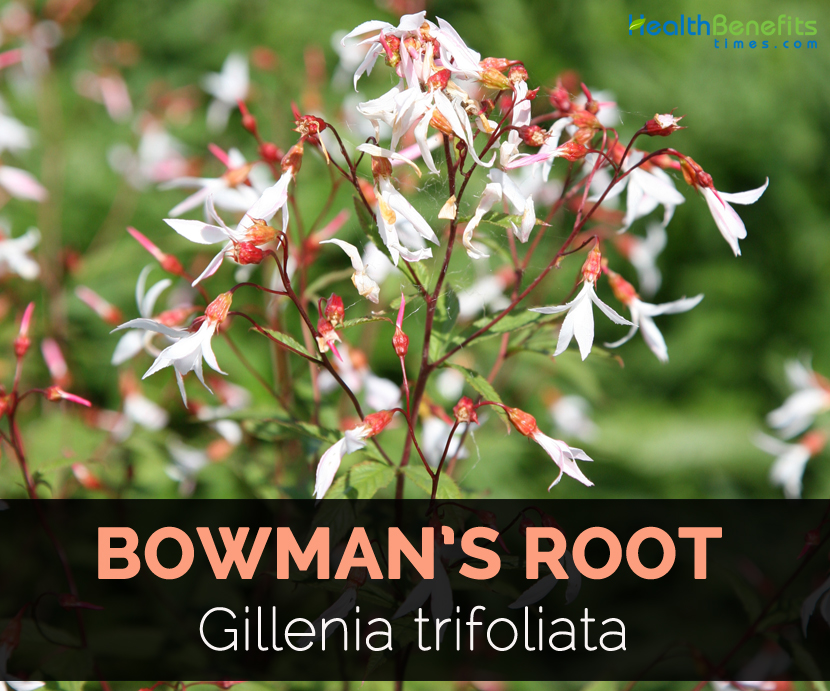| Bowman's Root Quick Facts | |
|---|---|
| Name: | Bowman's Root |
| Scientific Name: | Gillenia trifoliata |
| Origin | Native to eastern North America from Ontario to Georgia |
This indigenous shrub can be found scattered in North America: Canada to Florida, on the eastern side of the Alleghenies. Does well in open hilly woods, in light gravelly soil.
The root is quite thick with thin bark and many fissured rootlets, of bitter taste. The several erect, slender and smooth stems are 2–3 ft. high, and of a reddish or brownish colour. The leaves are alternate. Flowers are of white and pinkish colour, and can be seen in May. Matured fruit of two-valved, one-celled capsule, seeds are oblong, brown and bitter. The plant blooms with five petaled white flowers on wiry red stems from late spring to early summer.
History
The plant is found from Canada to Florida in rich woods, light, gravelly soils and in moist and shady situation. The flower blooms from May to August.
Facts About Bowman’s Root
| Name | Bowman’s Root |
|---|---|
| Scientific Name | Gillenia trifoliata |
| Native | Native to eastern North America from Ontario to Georgia |
| Common/English Name | Indian Physic, Bowman’s root, American ipecac |
| Name in Other Languages | English: Bowman’s root, Bowman’s-root, Mountain Indian-physic; Swedish: Gillenia; French: Gillénie trifoliée |
| Plant Growth Habit | Erect herbaceous perennial |
| Plant Size | 100 cm (39 in) tall by 60 cm (24 in) wide |
| Leaf | Alternate, trifoliate, subsessile |
| Medicinal parts | The bark of the root |
| Flowering Season | Spring to summer |
| Flower | White, 5-petaled, star-shaped |
Plant description
The herb is rhizomatous and perennial with semi-woody branches and 3-palmate leaves which blooms in midsummer with star shaped white or pale pink flowers. It is inherent to open woods with moist acidic to neutral soils and its native range is South East Canada to North Central and East USA from Ontario to Georgia. . Root is a medicinal part and is collected in autumn. It is nearly odorless and has nauseous and amorous taste. Roots are larger, tuberculated and rootlets resent on annulated appearance. It may be distinguished by drab colored and branching stems, its greater size, large, clasping, ovate-cordate, gashed, leafy and serrated stipules. Lower leaves are reddish brown color at the tips. Stipules are leafy, ovate and doubly incised and clasping. Flowers are fewer, smaller on slender peduncles hanging in loose panicles.
Medicinal uses
- North American Indians use it for treating amenorrhoea, dropsy, rheumatism, costiveness, dropsy, worms, dyspepsia, intermittent fever and worms.
- Use it internally in small doses for treating colds, constipation, diarrhea, asthma and bronchial complaints.
- Use the roots externally for rheumatism.
- For bee and other stings, use the cold root infusion or chew the roots.
- Use it as a wash for treating swellings and bee stings.
- Use the plant poultice for treating leg swellings.
- The plant is used for treating toothaches.
Dose
As an emetic, 20–35 grains of the powder, as often as required; as a tonic, 2–4 grains. As a diaphoretic, 6 grains in cold water, and repeated at intervals of 2–3 hr.
Side effects
Over doses of the infusion causes severe vomiting and purging.
References:
https://www.itis.gov/servlet/SingleRpt/SingleRpt?search_topic=TSN&search_value=514066#null
https://pfaf.org/user/Plant.aspx?LatinName=Gillenia+trifoliata
https://en.wikipedia.org/wiki/Gillenia_trifoliata
https://practicalplants.org/wiki/Gillenia_trifoliata
https://plants.ces.ncsu.edu/plants/gillenia-trifoliata/
https://westcoastislandblooms.wordpress.com/2015/07/02/gillenia-trifoliata/
Comments
comments
